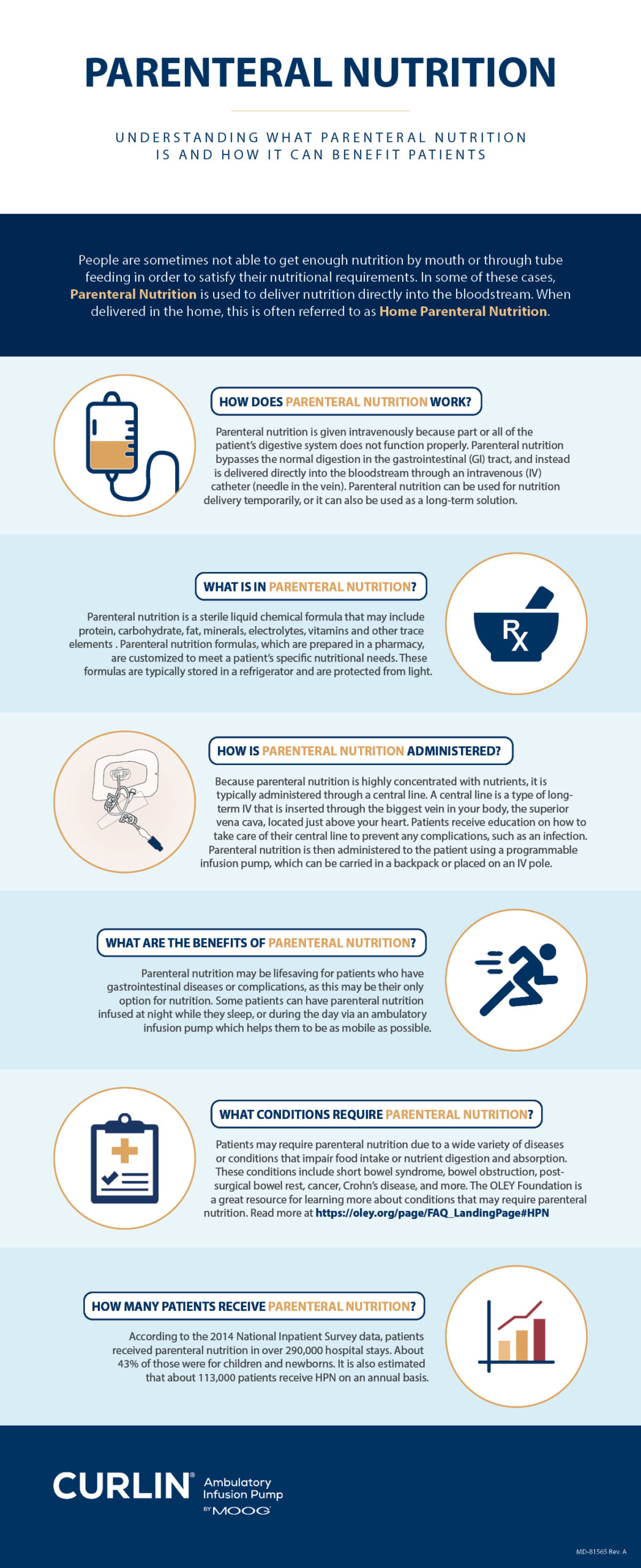TPN Administration Sets
Moog offers several CURLIN administration sets that are ideal for TPN use. Read about the unique features of each of these sets below.
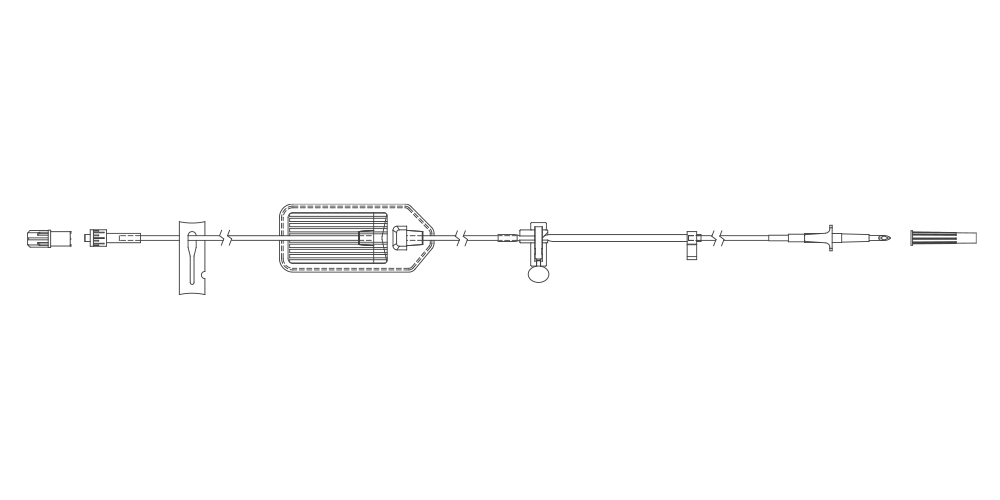
340-4128 CURLIN Infusion Administration Set
Order No: 340-4128
Administration set with non-vented bag spike, 1.2 micron air-eliminating filter, slide clamp, and male luer with vented cap. 2.5 m (99”) / 7.1 mL
For use with the CURLIN 6000 and CURLIN PainSmart Infusion Pumps
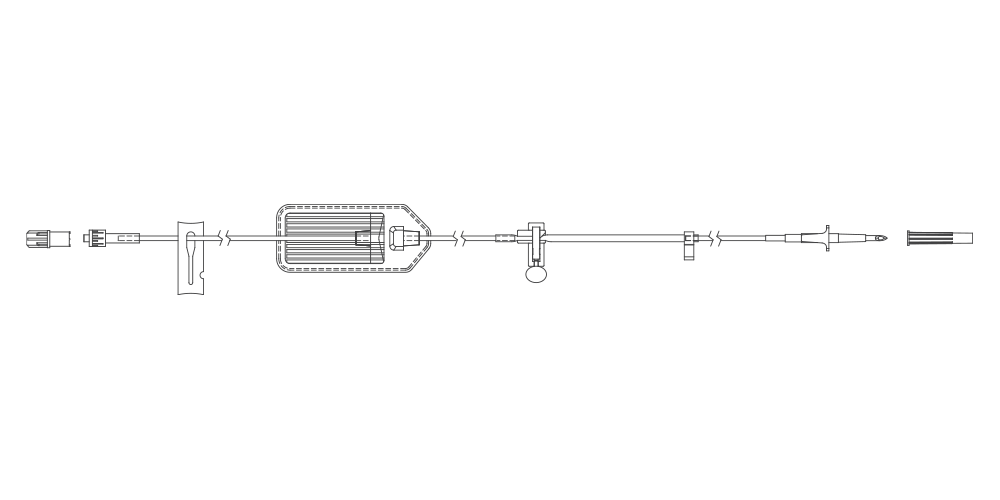
340-4128V CURLIN Infusion Administration Set
Order No: 340-4128V
Administration set with non-vented bag spike, 1.2 micron air-eliminating filter, slide clamp, male luer with vented cap, and add-on check valve (V). 2.5 m (99”) / 7.1 mL
For use with the CURLIN 6000 and CURLIN PainSmart Infusion Pumps
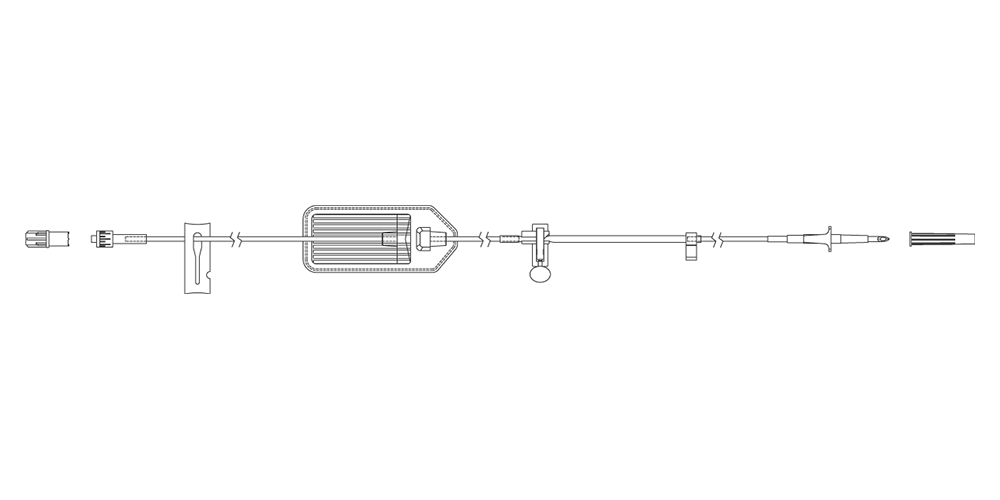
340-4130 CURLIN Infusion Administration Set
Order No: 340-4168
Administration set with non-vented bag spike, 0.2 micron air-eliminating filter, slide clamp, and male luer with vented cap. 2.5 m (98”) / 6.8 mL
For use with the CURLIN 6000 and CURLIN PainSmart Infusion Pumps
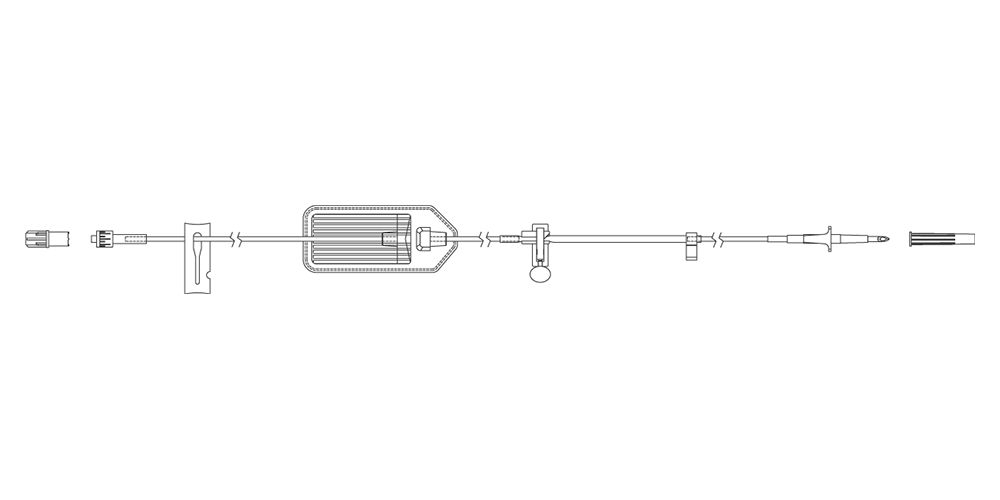
340-4130V CURLIN Infusion Administration Set
Order No: 340-4130V
Administration set with non-vented bag spike, 0.2 micron aireliminating filter, slide clamp, male luer with vented cap, and add‐on check valve (V). 2.5 m (98”) / 6.8 mL
For use with the CURLIN 6000 and CURLIN PainSmart Infusion Pumps
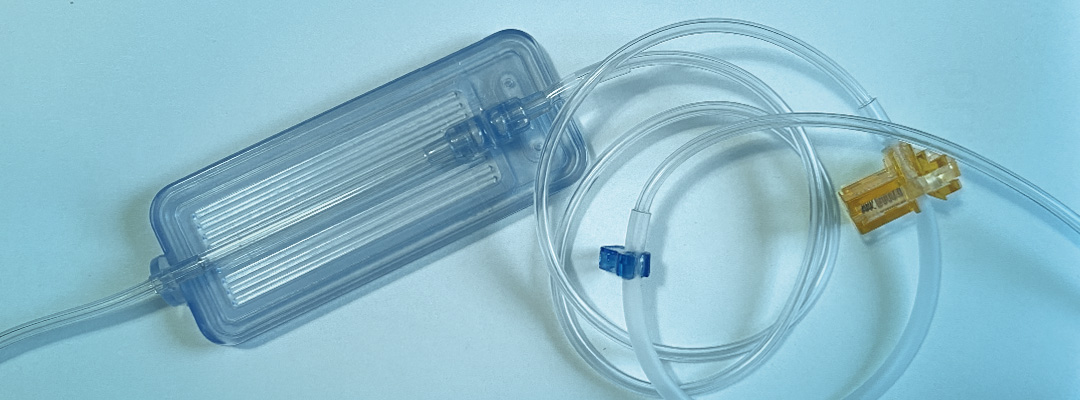
ASPEN Update on the Use of Filters for Parenteral Nutrition
CLINICAL EDUCATION SERIES
This paper highlights the most current research in filter usage, including the usage of filters for the primary purpose of filtering particulates. To eliminate confusion and workarounds, ASPEN now recommends using a 1.2 micron filter for all parenteral infusions. If you are a clinician that routinely infuses parenteral nutrition, reading this position paper can help gain knowledge on the harmful effects of particulates and summarizes the current evidence-based practices to safely administer parenteral nutrition. The entire paper can be read on the ASPEN Journals Website.Intravenous in-line filters play a critical role in promoting patient safety during parenteral nutrition (PN) administration. Guidelines for using filters for PN have been issued by a number of professional organizations and manufacturers of PN components. Yet despite this guidance, filter use remains controversial. Recent changes in recommendations for filtering lipid injectable emulsions have added to confusion and created considerable variation in practice. This Position Paper aims to review past guidance regarding the filtration of PN, examine the clinical consequences of infusing particulate matter, discuss the challenges and issues related to filtration, and clarify the American Society for Parenteral and Enteral Nutrition (ASPEN) recommendations for the use of filters for PN administration.
Complete this form and our clinical team will contact you soon to answer your questions and provide related information and updates.
If you are experiencing issues with any of our products, please contact us using our customer support form instead.

CURLIN Catch-Up: TPN Therapy Mode Review and Best Practices
Learn more about the TPN mode on the CURLIN 6000 through our "CURLIN 6000 TPN Therapy Mode Review and Best Practices" virtual training course.
Hosted by Cindy Sadler. Join us for a 30-minute course on using CURLIN 6000’s TPN therapy mode. This quick course will provide you and your team with a overview of the features and benefits of using TPN mode on the CURLIN 6000, along with a demonstration on how to program the therapy. Additionally, we will discuss the robust safety features of the CURLIN system, and how to apply current best practices for using TPN mode to infuse medications and fluids.
| Register Now | July 25, 2024 11:00 AM Mountain Time |

Cindy Sadler, RN
Sr. Clinical Services Specialist
Cindy Sadler RN is a clinical specialist with Moog Medical. Cindy joined Moog Medical in 2013. Prior to joining Moog she worked as an Emergency Dept. nurse, Emergency Dept. Director and Acute Inpatient Rehabilitation Director. She has found great satisfaction in serving all end users of our Moog Medical products.
Additional CE Courses and Training Workshops
Click on any of the courses below to learn more and to register.
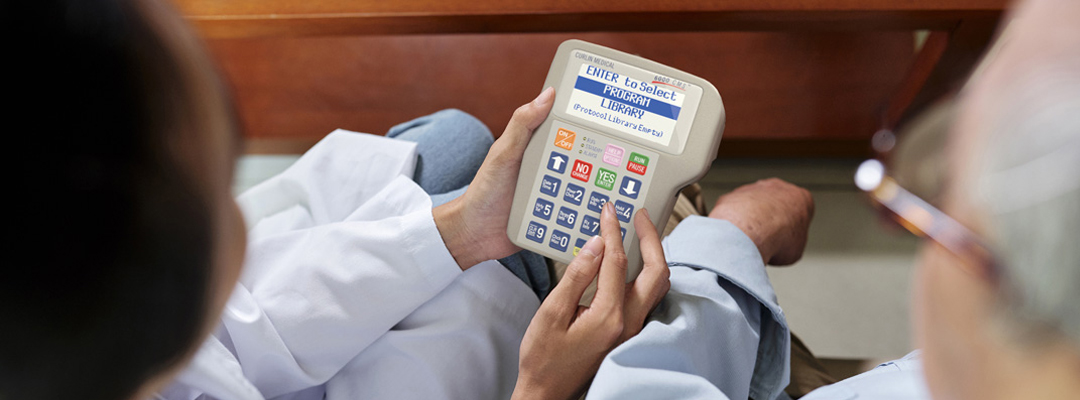
INS Standards of Practice Outline
CLINICAL EDUCATION SERIES
An updated version of the Infusion Therapy Standards of Practice (8th edition) was recently published in the Journal of Infusion Nursing (Volume 44 January/February 2021). As a manufacturer of medical devices, Moog Medical is proud to support and endorse the INS Standards and recognize the important work of the Infusion Nurses Society (INS). This organization, in collaboration with the National Home Infusion Agency (NHIA) and contributing clinical professionals, oversees the needs of the patients receiving infusion therapy to ensure that the best possible care is delivered to patients through best practices.
To assist you in providing the best possible patient care, this article will review a few important infusion nursing standards (INS) updates and how they relate to Moog Medical’s CURLIN Infusion Pump products.
When using a CURLIN Infusion Pump, it is important to understand how the pump and administration sets work together to provide the patient with a safe and effective ambulatory infusion option. Flow-control devices, as outlined in the INS Standard 24.1, should be selected “based upon factors including the prescribed infusion therapy, rate control requirements, infusion-related risks, patient care setting, and available resources within the organization.”
Best practice recommendations for use of electronic infusion pumps include many safety considerations. Two of these considerations include Education and Administration Set Management.
Education
Standard 8: Patient Education
Patient Education is defined in the INS Standards as:
8.1 “The patient/caregiver is educated about the prescribed infusion therapy and plan of care including, but not limited to, the purpose and expected outcome(s) and/or goal(s) of treatment, expected duration of therapy, risks and benefits, infusion therapy administration, VAD options and expected care, potential complications, adverse effects associated with treatment or therapy, and how to access health care services as needed.”
8.2 “Teaching strategies and learning materials are congruent with the knowledge and skills being taught and encompass patient/caregiver learning needs, abilities, and resources.”
The importance of understanding how to use an infusion pump and teaching patients and their caregivers how to manage their infusions and equipment, is also mentioned in Section Two: “Patient and Clinician Safety” and defined in Standard 12 and Standard 24.
Standard 12: Product Evaluation, Integrity and Defect Reporting
12.2 “Clinician and end users attain and maintain knowledge about developments and technologies relating to VADs, infusion products, and equipment to meet evidence-based standards.”
CURLIN pump training materials, education, and resources are available, free of charge, to all of our customers, including clinicians and patients using the CURLIN pump. Clinician training and education programs have been developed to assist the clinician in attaining and maintaining knowledge about the CURLIN pump and its use. Training tools are also available to assist the clinician in providing patient teaching.
Standard 24: Flow-Control Devices
The INS Standards and guidelines help us understand that the importance of education is paramount. Without receiving proper education, a patient or caregiver could experience a life-threatening injury. Becoming familiar with the CURLIN pump and administration sets, by participating in CURLIN pump clinical training programs and providing proper teaching and training to patients and caregivers using the CURLIN pump, will meet these standards.
Clinicians are responsible for teaching and training the end user, to prevent injury by:
- Inspecting equipment and reporting issues
- Troubleshooting potential issues
- Providing education and training for use of the product/equipment
- Utilizing the product manufacturer for education and clinical support
Moog Medical is committed to providing outstanding educational resources related to our products and accessories. Our clinical team is available by phone, 24/7 for pump-related education, troubleshooting, and assistance. Our website provides educational resources such as: training videos, clinical programming and troubleshooting guides, and a virtual CURLIN pump tour for a simulated “hands on” experience. We also offer CURLIN pump livestream training and eLearning programs, designed to support new and existing customers. These tools will assist you with your professional education, as well as when providing patient teaching- as outlined in the INS standards.
Standard 13: Medication Verification
The CURLIN Infusion Pump is capable of providing additional patient safety, through the Protocol Library Safety Software (PLSS) or Drug Error Reduction Software (DERS), as mentioned in Standard 13:
“Use electronic infusion pumps that include dose error reduction systems ([DERS] ie, smart pumps) with current and relevant drug libraries, as these are associated with reduced risk for infusion-related medication errors, including error interceptions (eg, wrong rate) and reduced adverse drug events.6,45,46 (II)”
Using a PLSS drug library with the CURLIN pump reduces the risk of a medication error by allowing a specific patient’s prescription with unique identifying information, dose/rate limits (MedLimits), and advisories- including specific drug protocols, to be downloaded to the CURLIN pump for a patient’s therapy. Pharmacists and providers are able to build and manage their own drug libraries based on their patient population and each patient’s needs.
Administration Set Management
Standard 43: Administration Set Management
Updated safety information, related to Administration Set management, has been added in Standard 43.
Utilizing proper priming technique, filter selection, and Aseptic Non Touch Technique (ANTT) with CURLIN administration set use/management recommendations will decrease the risk for patient harm. It is important to follow the package insert instructions for use (IFU), located in each CURLIN administration set, for proper priming technique, including filter position, during priming.
Loose CURLIN administration set tubing may create a trip hazard and increase the risk of strangulation. Coil and secure the excess length of tubing to prevent an accidental trip, fall, or traumatic removal from patient. The small blue vented caps, located at the distal end of the CURLIN tubing, may pose a risk for choking. Keep all small parts away from at-risk individuals, including children and pets. Use only approved CURLIN administration sets. Use of non-CURLIN administration sets could result in air infusion, under delivery, over delivery or free flow, that could result in patient harm.
Adherence to Standard 43, will reduce the risk for patient harm.
43.1 “Administration set changes are performed with adherence to Standard-ANTT at a frequency based upon factors such as patient condition, type, rate, and frequency of solutions administered, immediately upon suspected contamination, when the integrity of the product or system has been compromised, and when a new VAD is placed.”
43.2 “Administration sets are of a luer-lock design to ensure a secure connection, reduce manipulation, and minimize the risk of leaks, disconnections, or misconnections.”
43.I.L. “Minimize risk of strangulation or entanglement related to the use of administration sets. Research is needed to test preventative strategies such as individual risk assessment, ongoing assessment of need for continuous vs intermittent infusions, increased supervision or video surveillance, avoiding use of extension sets, coiling excess tubing, and use of accessories to stabilize flexible lines (eg, clear plastic sleeve over administration set).”
43.I.K. “Trace all catheters/administration sets/add-on devices between the patient’s access device and the solution container before connecting or reconnecting any infusion/device, at each care transition to a new setting, or service, and as part of the hand-off process.”
Standard 43: Set Change Frequency
A frequently asked question regarding our CURLIN administration sets is: “How long can a CURLIN administration set be used?” CURLIN administration sets and sets with filters are tested for use up to 72 hours. This testing includes delivery accuracy and set functionality. Both of which can be affected if CURLIN sets are used longer than 72 hours. The INS recommendation, for primary and secondary continuous infusions, not containing lipids, blood, or blood products, are outlined as follows:
43.II.A. “Replace primary and secondary continuous administration sets used to administer solutions other than lipid, blood, or blood products no more frequently than every 96 hours but at least every 7 days (unless otherwise stated in manufacturers’ directions for use), when the VAD is changed, or if the integrity of the product or system has been compromised.”
43.III.A. “Change intermittent administration sets every 24 hours.”
43.IV.A. “Replace administration sets with inline and add-on filters for PN solutions (with or without lipids) every 24 hours or with each new PN container.”
Standard 35: Filtration
If the CURLIN administration set includes an air-eliminating filter, refer to the administration set instructions for use (IFU) for proper filter positioning during priming. Also consider the type of therapy being delivered, medication protocol, and patient risks, when selecting an administration set with a filter. New information from ASPEN related to filter selection and use with TPN Infusions include the following information:
35.1: Parenteral Nutrition (PN) solutions are filtered using a filter appropriate to the type of solution:
G: “ASPEN published new recommendations for filtration that states: Use a 1.2-micron filter for all PN solutions including PN solutions with lipids [“total nutrient admixtures” (TNA)], dextrose-amino acid admixtures, and lipid injectable emulsions. To align with ASPEN, this new recommendation supersedes the INS Practice Recommendations for the use of 0.22-micron filtration for non-lipid solutions. Specifically, this revised guidance impacts Standard 35, Filtration, Practice Recommendation G (page S103)1 and Standard 63, Parenteral Nutrition, Practice Recommendation B1 (page S190).”
“Why is filtration of PN solutions critically important? What are the clinical consequences of particulate matter? In-line filters were initially developed for infection control purposes, but their role in protecting patients from the harmful effects of particulate matter has emerged as their primary purpose in infusion therapy. The main consequence of particulate matter is to the lungs. Symptoms may include fever, dyspnea, cough, respiratory failure, and even sudden death. Notably, when medications are co-infused with PN, there is an even greater increase in particulate matter. In 1994, the US Food and Drug Administration (FDA) issued a safety alert regarding patient deaths related to calcium-phosphate precipitation in PN solutions that led to microvascular pulmonary emboli.5 As a result, ASPEN worked in collaboration with the FDA to develop the filtration recommendations. Filtration poses challenges such as decreased flow rates, occlusion alarms and air locks. Cost has also been cited as a barrier to consistent use. Use of only 1.2-micron filters reduces the risk of errors associated with using 2 different types of filters not only by nurses but also by home care patients receiving PN and reduces cost. ASPEN provides procedural steps for the use of filters. In addition to the Position Paper, ASPEN has created a 2-page fact sheet that includes best practices for filter use, helpful illustrations, and guidance in trouble-shooting high pressure/occlusion alarms and potentially occluded filters.6”
For more detailed information and citations, please see the fact sheet www.nutritioncare.org/uploadedFiles/Documents/Guidelines_and_Clinical_Resources/IV-Filters-For%20PN-Factsheet.pdf
Summary
Thank you for taking the time to review these INS Standards updates and for understanding the importance of using these standards with the CURLIN Infusion Pump and administration sets in a clinical setting. By familiarizing yourself with this information and attaining knowledge to help keep your patients safe, you have already utilized the “Education” piece of this article. If you have any questions about this article or would like additional information about the CURLIN Infusion Pump and administration sets, please reach out to us, anytime. Our goal as the manufacturer is to support you, as you become familiar with and confident using the CURLIN pump.
Complete this form and our clinical team will contact you soon to answer your questions and provide related information and updates.
If you are experiencing issues with any of our products, please contact us using our customer support form instead.
We take customer privacy very seriously. Please see our Privacy Policy.

Preparing a patient for home parenteral nutrition (HPN)
The goal of beginning a patient on parenteral nutrition (PN) is always to support optimal nutritional care. Additional considerations, such as ensuring the best possible quality of life, often come into play when home parenteral nutrition (HPN) is initiated. If a patient feels comfortable with the therapy regimen, they are likely to be more compliant and settle into the routine of incorporating this life saving therapy into their daily life.
Transitioning from acute care or a skilled nursing facility to the home can be difficult for a patient and their caregivers. For those individuals who previously relied on healthcare professionals for their medical care administration, learning to incorporate a medical device and life-sustaining therapy into their everyday life at home can be very overwhelming. The patient must absorb a large amount of information, including instructions on how to handle and troubleshoot the infusion pump, use of any supportive medical devices, storage of TPN (Total Parenteral Nutrition), mixing additive medications into the TPN, scheduling of clinician home visits for labs, supply deliveries, and much more.
The daily stress of setting up therapy in the home can be fatiguing until there is confidence in technique and a routine established. Once the patient is metabolically tolerating the TPN (based on labs and physical response), the infusion time can be decreased to a night schedule of 8-12 hrs. Incorporating the infusion into a nighttime schedule reduces disruption to the patient's day and adds a huge benefit to their overall quality of life. Infusing during the night, while asleep, encourages a transition away from the burden of managing a medical condition, allowing the patient and caregivers to return to work, school, or social gatherings without bringing medical equipment along with them. In short, it restores a feeling of normalcy.
However, getting to this point takes consistent training and a variety of educational tools and support resources; all of which should reinforce best practices that foster safe independence. Education materials should be clear and concise, and ideally should be available in a variety of languages to better reach all patient populations.
Moog has the privilege of working with many outstanding pharmacy, nursing and distributor providers who are truly committed to providing excellent patient care. Below are just a few resources that our Specialty Pharmacy partners provide to help aid patients and their caregivers with the transition to HPN.
- Nutrishare: Transitioning TPN from Hospital to Home TPN
- Coram: Your guide to home total parenteral nutrition therapy
- Option Care Health: Patient Guide to Parenteral Nutrition
For additional information on how CURLIN infusion pumps are able to provide reliable and accurate TPN delivery, visit our CURLIN TPN therapy overview page.

Kathy Iacuone, RN, BSN
Sr. Manager, Clinical Services
Kathy Iacuone joined the Moog team as Clinical Services Manager in March of 2016. Kathy leads the external clinical team for both IV and Enteral product lines. She oversees daily customer support and product training. She supports all departments clinically to include: Sales, Engineering, Marketing, Regulatory, and Quality, as well as participating in new product testing and development.
A registered nurse for 33 yrs. her focus has been infusion in the alternate care space. She began her career in Boston-New England Medical Center, enjoyed travel nursing, working in Intensive Care units across the country for several years. Prior to joining the team at Moog, she held the position of Nurse Manager for 8 yrs. at CVS/Coram Specialty Infusion in Tampa.
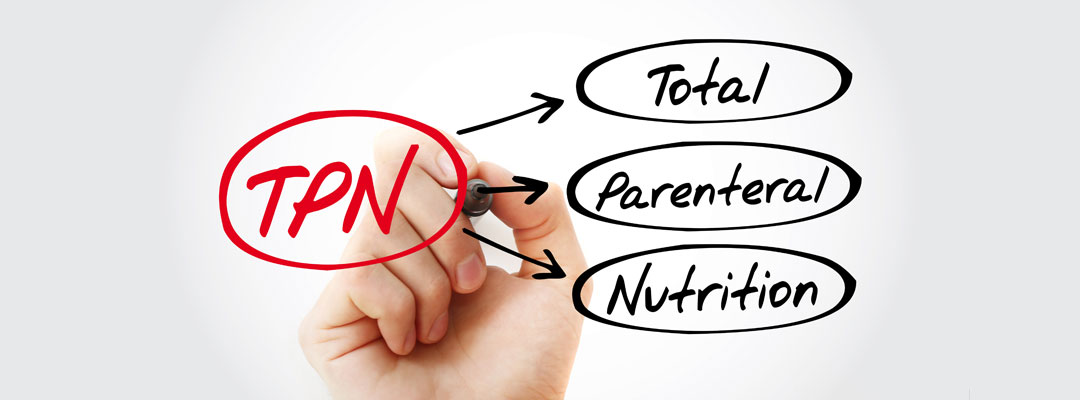
TPN and Quality of Life
Parenteral nutrition (PN) has been used to help patients with intestinal failure receive appropriate nutrition for over four decades. During that time, many advances in medical knowledge and technology have significantly increased the number of patients using PN in their homes, often using ambulatory infusion pumps such as the CURLIN 6000. While the nutritional benefits of home parenteral nutrition (HPN) have been well documented, there are still concerns with physical and social limitations that accompany this therapy, including a reduction in the the patient's quality of life (QoL).
In a 2019 study published in the Journal of the Canadian Association of Gastroenterology, researchers wanted to determine how transitioning from hospital-based Parenteral Nutrition to Home Parenteral Nutrition (HPN) affected patients' anxiety, depression, and quality of life. The study looked at 29 patients, 15 of which also had an underlying malignancy. At baseline, 93% of the patients with an underlying malignancy reported depression or anxiety or both, while of those patients without malignancy 60% reported experiencing anxiety and 40% depression.
To capture changes in patients' anxiety, depression, and quality of life, questionnaires were completed by 21 patients after one month on HPN and 15 patients after three months of HPN. These questionnaires found that both anxiety and depression scores decreased significantly after one month of HPN therapy, though this decrease was not sustained at the three month follow-up. When looking at the subgroup of patients with underlying malignancy, researchers found that after one month of HPN, anxiety and depression decreased significantly, and the effect was sustained at three months of HPN.
Additionally, after one month, researchers discovered that the health-related quality of life scores and physical health scores of both patients with and without malignancy showed significant improvement. This improvement was observed in physical functioning, bodily pain, vitality, social functioning, and mental health scores. And more importantly, these improved scores were found to persist even at the three-month mark.
Based on these results, the researchers were able to conclude that the transfer of PN treatments from the hospital to the home setting was associated with improved patient outcomes, including a decrease in depression and anxiety and an increase in overall quality of life. Additionally, researchers noted that the beneficial effect of HPN is more evident in those with underlying malignancy, suggesting that improved nutrition delivery may confer some benefit at the end of life.
As the industry leader in home infusion technology, the CURLIN 6000 by Moog provides patients the freedom and flexibility of receiving their infusions at home. Its unique design ensures that fluid and medication are delivered precisely as prescribed, which is especially important when delivering TPN therapy. Learn more about CURLIN’s unique design and how it can impact TPN delivery.
Study Link: https://academic.oup.com/jcag/article/2/4/178/5069370
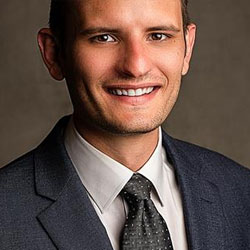
Ryan O'Reilly
Ryan O'Reilly is the Product Marketing Manager for Moog's IV Infusion business. Ryan received his BS in Strategic Communications from the University of Utah in 2014 and his MBA from Westminster College in 2021. Ryan has worked in various industries including med device, healthcare, and software. Outside of work, Ryan enjoys reading and cheering on the Utah Jazz.

Understanding Parenteral Nutrition
People are sometimes not able to get enough nutrition by mouth or through tube feeding in order to satisfy their nutritional requirements. In some of these cases, Parenteral Nutrition is used to deliver nutrition directly into the bloodstream. When delivered in the home, this is often referred to as Home Parenteral Nutrition.
We recently created the infographic below to help readers learn more about how parenteral nutrition works, how it is administered, and provide links to other parenteral nutrition resources that are available.
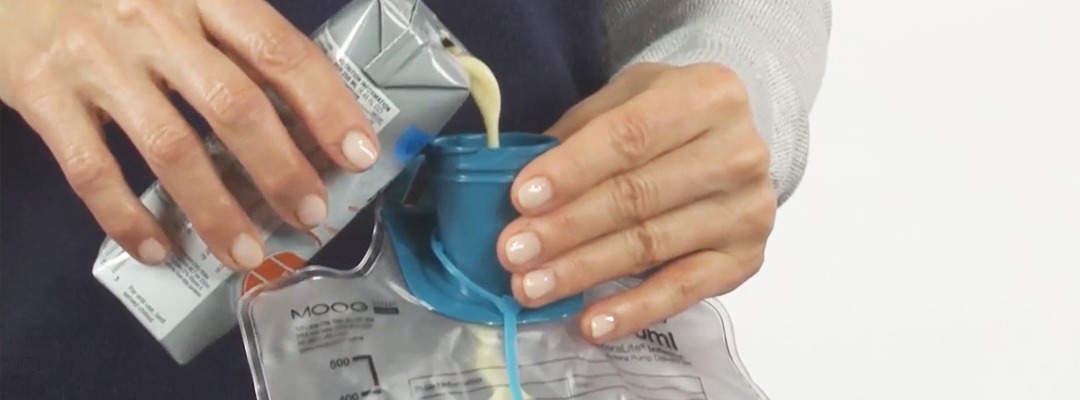
What is the Difference Between Enteral and Parenteral Nutrition?
All people need food and nutrition in order to survive. Sometimes, due to illness, surgery, or other reasons, individuals are unable to get the nutrition their bodies require. It then becomes necessary for these individuals to receive nutrition through alternative methods. These methods are categorized as Enteral or Parenteral Nutrition. See the infographic below to learn about the differences, and similarities, of these nutrition delivery methods.
The Infinity Enteral Feeding Pump is a rugged and reliable enteral feeding pump that enables patients to maximize their activity. The CURLIN Ambulatory Infusion Pump is regularly used by patients to receive parenteral nutrition.
Complete this form and we will contact you soon to answer your questions on how CURLIN pumps are used for TPN therapy and provide related updates.
We take customer privacy very seriously. Please see our Privacy Policy.
Industry-leading clinical and customer support options right at your fingertips.
From 24 hour per day clinical support, to live stream training, self-paced e-Learning, and onsite education in your facility; our clinical and customer support teams offer the most comprehensive technical training and support in the industry. Call us at 1.800.970.2337 or click the button below for assistance. You can also find online support with our training videos, troubleshooting, FAQs, and download library.








